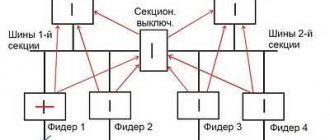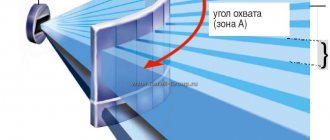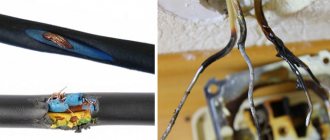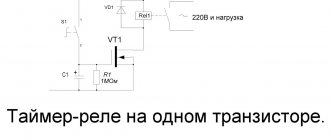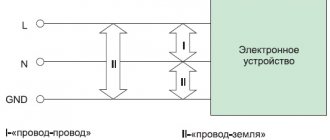Electromagnetic radiation in medicine.
Main directions (trends) of modern radio engineering: penetration of radio engineering ideas into medicine
Introduction.
Not long ago it was 100 years since the world's first use of electromagnetic waves for practical purposes. On February 6, 1900, the Russian physicist and inventor of radio Alexander Popov, having learned about the misfortune - 27 fishermen were carried away into the Baltic Sea on a broken ice floe - sent a radio dispatch 50 kilometers away to the island of Gogland, where the icebreaker Ermak was stationed - to urgently leave at sea to search for victims. Thus, thanks to the “miracle of the latest technology,” people were saved.
The past hundred years have been a true triumph in the use of electromagnetic energy by man. It is difficult to imagine modern life without radio, television, radar, and the Internet. But all this technology originates from those modest first experiments of the great Russian scientist.
It turned out that by converting electromagnetic waves (which is what modern radio technology does) it is possible to make sound visible and light audible. Modern physicists are struggling to master new, shorter electromagnetic wavelengths, the new ranges of which open up unprecedented possibilities. The ideas of radio engineering are widely used in many areas of human activity, including medicine.
Electromagnetic radiation in medicine.
After the invention of radio, as more and more powerful radio transmitters were created, people working at radio stations began to experience strange phenomena; Mainly disorders of the nervous system were noted, and people who worked at the radio station for a long time often had a fever. Since these symptoms were not associated with any physical diseases, it was assumed that they were caused by radio waves. This phenomenon is called “radio fever.”
Scientists were primarily interested in the mechanism of action of electromagnetic radiation on a living organism. At that time, the electrical processes occurring in a living organism were already known, so the logical conclusion was that an organism in which electrical phenomena occur could not remain indifferent to the external electromagnetic field. Scientists have long known that electric shock causes muscle contraction. In addition, it has been shown that the human body is most sensitive to current with a frequency of 50-100 Hz, and sensitivity decreases to currents of higher or lower frequencies. Consequently, radio transmitters operating at frequencies of several hundred kilohertz and even megahertz should not have caused irritation. However, this conclusion was contradicted by the symptoms observed among radio station employees.
It is known from physics that if radio waves are absorbed by some medium, then electromagnetic energy is converted into thermal energy and the medium heats up. Since electromagnetic radiation causes an increase in temperature in a living organism, scientists have suggested that the unpleasant sensations people experience are due to increased heat production as a result of exposure to electromagnetic radiation. This hypothesis was confirmed experimentally (it was also supported by the fact that during the Second World War, soldiers servicing radar devices discovered that microwave radiation from radars had a warming effect: in the winter months, people warmed their cold hands in the radar radiation beam). At the same time, some astute researchers realized the benefits that the thermal effect of radio emission could bring to the treatment of patients.
The general disadvantage of traditional methods of heat treatment is due to the fact that thermal energy enters the body from a heat source located outside it through heat transfer. This causes uneven distribution of heat between tissues; Mainly the outer surface (skin) and the adjacent fatty tissue are warmed, while the temperature of deeper tissues and organs (muscles, tendons) remains virtually unchanged, although, as a rule, they are the ones who need heat. In order to increase the temperature in deep tissues by several degrees, a heat source with a temperature of 70-800C should be placed on the surface of the body. For obvious reasons, this is not possible due to the danger of burns and severe pain (the nerve endings that perceive pain are located in the superficial layer of the skin). The use of high-frequency radio emission allows one to achieve an increase in temperature inside the body and carry out deeper heating of tissues.
One of the methods used in medicine is the capacitor field method. The area of the body that needs heating is placed between two metal electrodes that are not in contact with the body. The electrodes placed opposite each other behave like two plates of a parallel-plate capacitor, and a high frequency current can pass through the capacitor.
However, this method is still unsuitable for heating deep tissues. As experiments have shown, electromagnetic radiation penetrates the body deeper, the higher the frequency of radiation. Scientists have proven that radiation from radar devices operating at a frequency of 2500 MHz is suitable for therapy. Since this radiation falls in the microwave range, the healing method based on their use is called microwave therapy.
Microwave diathermy devices allow you to warm up the underlying tissue to a greater or at least the same extent as the skin. They are used primarily for the treatment of rheumatic diseases.
High-frequency diathermy devices are also suitable for “athermic” therapy, i.e. therapy not associated with an increase in body temperature. During this procedure, such a small amount of thermal energy is generated in the patient’s body that it does not produce heat. This method is especially beneficial in acute inflammatory processes. It is also known that after completion of such treatment, vasodilation persists for a long time in the irradiated areas; this improves blood circulation in the area of inflammation.
Radiotelemetry.
Nowadays, launching spaceships has become almost an everyday activity. In the case when there are astronauts on board the spacecraft, the first thing of interest is the state of their vital functions. The mission control center receives detailed information about the astronaut’s blood pressure, pulse and respiration rates, body temperature, etc. via telemetry. (Measuring at a distance using radio waves is called radio telemetry.)
Remote diagnostics therefore plays a very important role. The development of telemetry devices is one of the tasks of modern radio engineering. Let's look at how one of these devices (electrocardiograph) works:
The heart's action potential is sensed by electrodes attached to various points on the chest. The electrocardiograph amplifier senses the biocurrents of the heart. The amplified signals enter the transmitter modulator, and the high-frequency electromagnetic oscillations modulated by them are sent by the antenna into space. The antenna of the receiving device picks up radio waves, which are converted into the original ECG signals by the demodulator of the receiving device. In this way a conventional electrocardiogram is obtained. The maximum distance between the transmitting and receiving devices depends on the transmitter power and the sensitivity of the receiver. The range of conventional telemetry devices ranges from several tens of meters to several kilometers.
Obviously, telemetry devices are much more complex than conventional measuring instruments, and they must be small in size and transportable. Thanks to the achievements of modern radio technology, the creation of portable medical devices and instruments now does not present any particular problems. In other words, telemetry is needed today not because without it it is impossible to establish a direct connection between the patient and medical equipment. The main advantage of this method is the ability to obtain reliable, objective results. Everyone knows from their own experience that even the simplest medical examination does not go unnoticed for the patient, and it is likely that his anxiety will affect the results of the measurement. Distortion of results caused by psychological factors can be avoided if the study is carried out not in the presence of a doctor, but using a telemetry device. The transmitting device is attached to the patient, who is in the ward or, for example, walking in the hospital garden, and the doctor, using the receiving device, monitors the vital functions of interest to him.
In some cases, pathological changes cannot be detected using traditional research methods. Thus, it happens that an electrocardiogram taken from a bedridden patient may not show any abnormalities, although the patient complains about his heart. The reason most often is that pain appears only during physical activity, but a conventional electrocardiograph does not allow taking a cardiogram from a moving patient.
Biotelemetry devices are also important in cases where direct medical examination is not possible, for example during space flight. The same is true for sports medicine: the doctor’s task is to determine the athlete’s load tolerance during training. Without a telemetry device, this is only possible if the athlete temporarily interrupts training and the doctor records the research data. However, this method will not allow us to determine what, for example, happened to an athlete who was forced to interrupt a long-distance run, because by the time the doctor arrived, the physiological parameters of the runner had already changed.
Much more reliable data can be obtained if a miniature telemetry sensor is attached to the runner. In this case, the doctor, using a receiving device, is able to monitor the athlete’s cardiac activity (pulse rate, ECG data, etc.). The telemetric research method allows the sports doctor to monitor the athlete’s condition during training and, at the right time, bring him to the best sports shape. Athletes undoubtedly owe many of the outstanding achievements of recent years to the use of telemetry devices during training.
Widespread implementation of the biotelemetric method is hampered by the relatively high cost of the devices. In addition, data obtained telemetrically while the subject is moving is not always amenable to conventional decoding methods. However, these shortcomings can be eliminated and we can safely say that the introduction of the telemetric method into medical practice opens up new opportunities for early and accurate diagnosis of diseases.
Recommended pages:
Use the site search:
ELECTRONIC RADIATION
ELECTRONIC RADIATION
- corpuscular ionizing radiation, consisting of a flow of free electrons. In medicine, electron radiation is used for electron therapy (see), radioisotope diagnostics (see), as well as in biomedical research, including those carried out using electron microscopy (see).
Electron
(Greek elektron amber) is a stable elementary particle (see Elementary particles), discovered by JJ Thomson in 1897. The electron is the lightest particle with rest mass. Its rest mass is m=9.109·10-31 kg, which corresponds to an energy of 0.511 MeV. Electron charge e = -1.602·10-19 k, spin (s) in Planck units is equal to 1/2 or 1/2 · (h/2π) where h is Planck’s constant, equal to 6.626·10-34 J·sec. Magnetic moment of an electron μe = (e h) / (4πmc) = 9.274 10-24 J tl-1, where c is the speed of light.
Electrons are part of atoms (see Atom) and molecules (see Molecule), neutralizing the positive charge of nuclei and forming electron shells located around them. The structure of the electron shells of an atom and the quantum mechanical features of the movement of atomic electrons determine the optical, electrical, magnetic, chemical and mechanical properties of matter. Sources of free electrons in nature are cosmic radiation (see), the decay of some elementary particles, beta decay (see). Free electrons can also be emitted when excitation of atoms of the medium by supplying energy of a different nature, for example. heating (thermionic emission), irradiation of the medium with electrons, ions (see) or photons (electron, ion and photoelectron emission, formation of ion pairs).
Electron radiation, organized into electron beams, is obtained at charged particle accelerators (see) of various types. Linear accelerators are most widely used in research on electron radiation of a wide range of energies (from several megaelectron volts to ~ 20 GeV).
Passing through the substance of the medium, electrons interact with its atoms. Such interaction processes include elastic scattering and braking in the Coulomb field of the nucleus, which leads to the so-called bremsstrahlung (see); inelastic scattering by electrons of atoms of the medium and excitation of these atoms (see Molecule, excited states of molecules); nuclear reactions (see). Elastic scattering does not change the energy of the primary electron radiation, but plays an important role in expanding the transverse dimensions of the electron beam as it passes through the medium. The main processes leading to the loss of energy of electron radiation are inelastic scattering and excitation of atoms of the substance of the medium, as well as the deceleration of electrons in the field of the nuclei of atoms of the substance of the medium. In the energy range of electron radiation from 0.1 to ~ 1.5 MeV, ionization losses (in g/cm2) per unit path length are proportional to the electron density of the medium and inversely proportional to the square of the particle velocity. Linear energy transfer (see), that is, the average energy absorbed by the medium at the point of passage of a charged particle, per unit of its path, when an electron is decelerated in the field of the nucleus of an atom of the medium, is proportional to n * Z2 * T, where T is the kinetic energy of electron radiation, Z is the effective atomic number of the medium, n is the number of atoms in 1 cm3 of the medium.
The energy at which the ionization energy loss of an electron is equal to the radiation energy loss (energy loss due to radiation during braking) is called critical (see Ionizing radiation). When the energy of electron radiation is above the critical value, radiation losses represent the main type of energy loss. Electronic field energy losses for ionization and bremsstrahlung in water (body tissues) are respectively 0.225 and 0.0196 keV/μm (T = 10 MeV), 0.241 and 0.0475 keV/μm (T = 20 MeV) , 0.264 and 0.139 keV/µm (T = 50 MeV).
The path of an electron in a medium R (cm) depends on the density of the medium p (g/cm3) and the electron energy (MeV). In the energy range of electron radiation from 1.5 to 35 MeV, the dependence of R on T with an error of less than ±5% is described by the empirical relation pR = 0.51T - 0.26. For clinical purposes, important characteristics of the spatial distribution of the dose or dose rate of electron radiation in the irradiated environment (see Dose field) are the distributions of the absorbed dose in water or biol. tissue (see Isodoses).
The biological effect of electronic radiation is similar to the effect of gamma radiation (see) and bremsstrahlung radiation of the same energy (see Ionizing radiation, biological effect).
See also Beta radiation.
Bibliography:
Kozlov A.P. et al. Comparison of the biological effectiveness of 20 MeV electrons and 200 kV X-ray radiation on the formation of chromosomal aberrations in Ehrlich tumor cells, Radiobiology, vol. 14, century. 4, p. 536, 1974; Experimental Nuclear Physics, ed. E. Segre, trans. from English, vol. 1, p. 143, M., 1955; Johns N. E. a. Cunningham JR The physics of radiology, Springfield, 1983; Textbook of radiotherapy, ed. by G. H. Fletcher, Philadelphia, 1980.
A. P. Kozlov.
Electromagnetic radiation: sources and causes
Do you know why selected wavelengths are used for communication? The military and the state take away the sweet spots of electromagnetic radiation. Distribution conditions are heterogeneous. Let's say sonars operate at wavelengths of 20 meters. Communication frequencies are quickly damped by water.
Why do microwave ovens, cell phones, and Wi-Fi use strictly defined portions of the spectrum? The waves fade into the fog. We pay so that the messages are quickly absorbed by the environment, water, by the body, which contains 60–65% water.
While we hold the phone receiver with our hand, we will gain electromagnetic energy. The operating principle of a microwave oven. We decided to conduct an experiment: we found a contactless indicator screwdriver with a light and sound alarm in a store, and examined a home microwave oven. We did the following:
Typical Research Master
- The magnetron is turned off at low power; higher modes were avoided. The radiation was minimal; the microwave oven model does not produce less.
- In the first part of the experiment, the microwave is connected to an outlet and equipped with a protective grounding designed according to European standards. It can be seen that there is a cable channel coming down from above, which is allowed by the standards.
- In the second part of the experiment, an extension cord without grounding petals was used. The result was a violation of European technology standards. See the result caused by electromagnetic radiation.
We remind you that the contactless screwdriver-indicator inside the case contains active amplifying elements powered by a simple battery. Receives weak signals from external sources. The operating principle is reminiscent of a Soviet indicator screwdriver. The phase is found by touching the current-carrying part. However, the active amplification part introduces significant adjustments:
- Due to its high sensitivity, the probe of the non-contact indicator screwdriver works by imitating the receiving antenna.
- Reacts sensitively to the 50 Hz range due to its intended purpose. With the contact method, the presence of a phase is always recorded; only electromagnetic radiation generated by the movement of current is detected at a distance. A wire without a load will not give a signal.
- The indicator screwdriver demonstrates 2-3 sensitivity ranges (see photo). In our case, we used the maximum one for clarity.
Sensitivity button
The results of the experiment are amazing; the effect of electromagnetic radiation is presented in photographs:
- The first photo shows: protection against electromagnetic radiation is achieved by connecting the device to a European socket equipped according to the rules. The housing, being grounded, forms a shield. Otherwise, half of the radiation will go outside, the second will harm the inside of the microwave oven, causing parasitic effects.
Grounded socket
- The second photo shows: if the connection is correct, the indicator screwdriver is silent at a high level of sensitivity, being close to the body. This means that the level of electromagnetic radiation is negligible and there is no effect on the body.
No electromagnetic field
- The next photo shows an old extension cord with a missing grounding tab. A correctly installed European socket is now inactive. The result is amazing! The device produces such strong electromagnetic fields that they can be felt at a distance of 30 cm (minimum) from the microwave oven. They showed in the picture a light indication of a green light (does not mean “safe”), the ratchet buzzer of the indicator screwdriver can cause deafness.
Connection without grounding
Presence of electromagnetic field
Draw conclusions. The influence of 2.4 GHz radiation on humans has long been proven (challenged in court, the researcher’s rights were restored by the next court), the wavelength of the microwave oven is the same, the energy is so great (without grounding) that it triggers the indicator at a considerable distance. Take the trouble to install electrical wiring as prescribed by the standards. Sockets should be equipped with grounding petals so that the equipment body suppresses the effects of electromagnetic radiation, serving as a shield.
